What's the best flooring choice for each room in your home? Picking the right material is not just about looks- it's about comfort, function, and long-term value.
Some floors stand up better to spills, while others offer cozy warmth or stylish luxury. From busy kitchens to peaceful bedrooms, each space has unique needs.
Flooring also affects how rooms feel underfoot and how easy they are to clean. With so many options, making the right decision can be tricky.
This guide reveals the top flooring types for every room so your home feels just right. Read on!
Living Room Flooring: Comfort Meets Style
Because the living room is frequently considered to be the "heart" of the home, the flooring in this room should provide both comfort and charm. When it comes to living rooms, hardwood flooring is a classic choice because of the natural beauty and warm tones that it can provide. It enhances the value of your home while also adding a touch of elegance.
If comfort is of the utmost importance, carpet is a good option because it is comfortable to walk on and it also acts as a sound insulator. In addition to being reasonably priced, luxury vinyl planks are available in finishes that are similar to those of wood. Adding warmth and texture to hard floors can also be accomplished by layering area rugs on top of them.
Another practical option is laminate, which is an option that is resistant to scratches and is simple to maintain. It is important to take into consideration your lifestyle and the amount of traffic you experience when selecting a material. Choose a floor that not only reflects your style but also can withstand the wear and tear of everyday life.
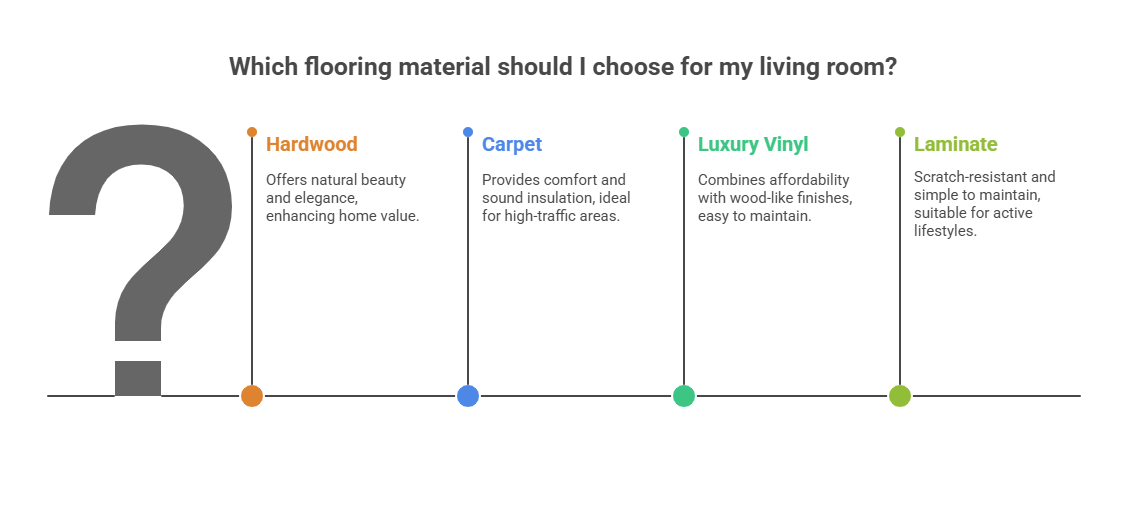
Kitchen Flooring: Durability and Easy Cleaning
Kitchens are high-traffic areas prone to spills, so flooring must be durable and easy to clean. Ceramic tile is a top pick for its water resistance and wide range of colors and designs.
Vinyl is also a popular choice-it's softer underfoot and easy to maintain. Engineered hardwood offers a warm look while handling humidity better than traditional wood.
Laminate can mimic tile or wood and is budget-friendly, though less water-resistant. Rubber flooring is also making a comeback due to its softness and slip resistance.
Consider textured finishes to prevent slips when the floor is wet. A sealed stone floor offers luxury and resilience but may need more upkeep. No matter the choice, prioritize water resistance, comfort, and style.
Bathroom Flooring: Water Resistance Is Key
Bathroom floors must handle constant moisture while staying safe and stylish. Ceramic and porcelain tiles are top choices for their waterproof nature and stylish patterns. They are easy to clean and work well with radiant heating.
Vinyl flooring, both sheet and tile types, is a great alternative for tighter budgets. It's also warm underfoot and comes in many modern designs. Natural stone like marble or slate adds a touch of luxury but requires sealing to avoid water damage.
Avoid hardwood and laminate as they may warp in damp conditions. Textured tiles reduce slip hazards, especially important in wet areas. Choose a surface that resists water and mold while enhancing your bathroom's design.
Bedroom Flooring: Warmth and Softness Matter
Bedrooms are your retreat, so the flooring should feel warm and cozy. Carpet is a top choice here because of its softness and sound-absorbing qualities. It also adds a sense of comfort and reduces noise, which is perfect for sleeping areas.
If you prefer a hard surface, hardwood floors bring natural charm and warmth. Area rugs can soften the space and add color. Cork is another unique choice, providing a soft, warm surface with eco-friendly benefits.
Engineered wood is suitable for those who want a wood look with more durability. Vinyl planks offer a comfortable surface and work well for allergy-sensitive individuals. Pick a floor that enhances relaxation while matching your bedroom decor.

Dining Room Flooring: Balancing Elegance and Function
Dining rooms need to have flooring that is not only lovely but also simple to clean after meals. The use of hardwood flooring lends an air of sophistication to a space and works wonderfully with dining furniture.
Engineered wood produces a similar appearance while providing increased stability. If you are concerned about spills, you might want to consider luxury vinyl because it has the appearance of stone or wood but is resistant to stains and moisture.
Additionally, laminate flooring offers a stylish appearance at a lower cost and is simple to clean with a wipe. Rugs can define the dining space and add a layer of comfort beneath the table. Even though it is less common, tile flooring is a practical option for frequent entertaining.
Carpets that are excessively soft or have a high pile should be avoided because they have the potential to collect crumbs. Select a surface that not only adds elegance but is also capable of readily accommodating family dinners.
Home Office Flooring: Comfort and Noise Control
Your home office must encourage concentration, comfort, and professionalism. During phone calls or video conferences, a carpet is an excellent choice for reducing background noise.
Sitting at a desk for long periods also provides warmth and comfort. Hardwood or laminate flooring is a visually appealing option that is also simple to maintain. Considering vinyl flooring with a cushioned backing is a good option for striking a balance between comfort and style.
Cork flooring provides a surface that is gentle and warm, making it an excellent choice for standing desks. Not only can rugs help define the workspace, but they can also help absorb sound.
It is recommended that you choose hard flooring and a chair mat to protect the surface of your rolling office chair if you use it. Comfort, low noise, and a professional appearance should be your top priorities.
Basement Flooring: Moisture-Proof and Durable
Basements often have higher humidity and risk of water leaks, so flooring must be water-resistant. Vinyl planks or tiles are ideal due to their moisture resistance and easy installation. Sealed concrete is also a practical option-it's durable and can be stained or painted for style.
Rubber flooring is great for multi-use spaces or gyms. Engineered wood can be used if the basement is well-sealed and moisture-controlled. Avoid solid hardwood, as it can warp in damp conditions.
Laminate may work with a moisture barrier underneath. Carpet tiles are a softer option and easy to replace if damaged. Focus on materials that resist moisture while making the space livable.
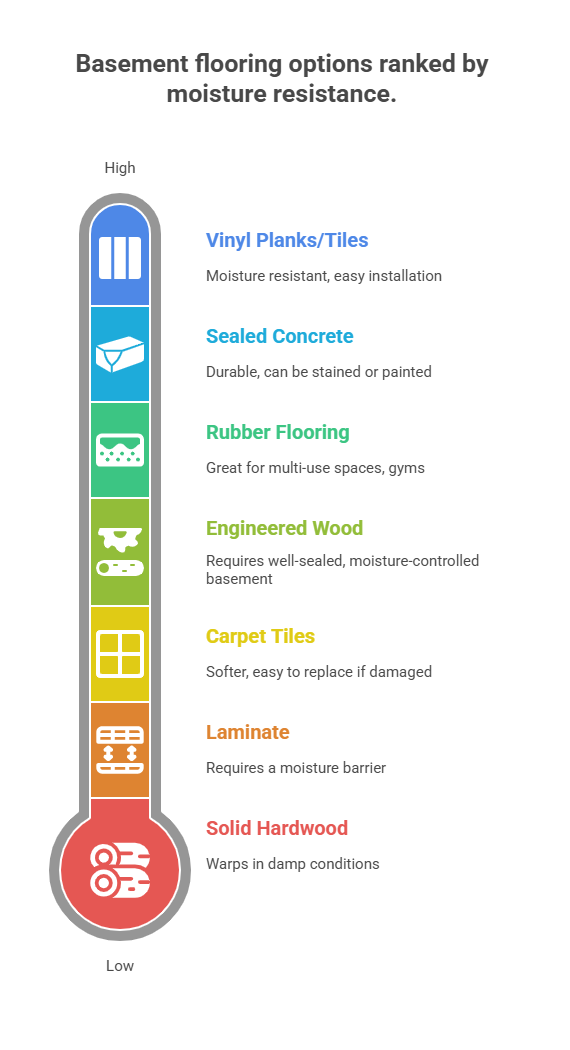
Entryway and Foyer Flooring: First Impressions Matter
Because entryways are subjected to a significant amount of foot traffic and dirt, the flooring in these areas needs to be long-lasting and simple to clean. The durability and resistance to water that tile possesses make it an excellent material choice, particularly porcelain.
Despite the fact that it requires sealing, natural stone has a look that is both dramatic and elegant. Additionally, vinyl or laminate are viable options that are both cost-effective and have a high level of durability.
It is beneficial to protect the floor with rugs or mats, as they collect dirt from shoes. Steer clear of carpet because it is prone to staining and retains moisture. When it is raining, select textures that will prevent you from slipping.
Because it is the first part of your home that guests see, you should strike a balance between appearance and functionality. Pick a floor that is comfortable to walk on while also being resistant to wear and tear.
Laundry Room Flooring: Tough and Water-Safe
The laundry room faces water spills, heavy machines, and frequent traffic, so the flooring needs to be strong and water-resistant. Vinyl flooring-especially sheet vinyl-is a top choice due to its seamless, waterproof surface. Ceramic tile is another great option, offering both style and protection.
Concrete works well in modern laundry areas and is easy to maintain. Laminate is not recommended unless it's water-resistant and well-sealed. Rubber flooring is soft underfoot and resists slipping.
Engineered wood can be used if there is excellent moisture control. Consider adding rugs or mats near washers and sinks.
Hallway Flooring: Durable for High Traffic
Because hallways connect rooms and are frequently used, the flooring in these areas needs to be both long-lasting and fashionable. Hardwood is a popular option because it has a classic beauty and can withstand wear and tear at the same time.
Laminate is an alternative that is more cost-effective, with the ability to imitate wood while also being scratch-resistant. Also, vinyl planks are a good option, particularly in households that have children or animals.
Tile is a material that is long-lasting and durable, but it can be uncomfortable to walk on. Flooring can be protected by area runners, which also add warmth to the floor. To lessen the appearance of scuffs, you might want to think about using textured or matte covers.
Soft materials, such as different types of carpets, which wear out quickly in confined spaces, should be avoided. It is important to choose a floor that is long-lasting and can easily connect the various rooms.
Kids' Room Flooring: Safety and Fun
Children's rooms need safe, comfortable, and easy-to-clean flooring. The carpet offers a soft landing for playtime and helps reduce noise. Look for stain-resistant types for easier upkeep.
Cork is another excellent option-it's soft, warm, and naturally antimicrobial. Vinyl planks are practical and come in colorful styles kids enjoy. Foam mats or rugs can be layered for added safety.
Avoid hard or slippery floors that could cause falls. Laminate is okay if combined with a rug for comfort. Choose a material that supports both fun and safety in a lively environment.
Guest Room Flooring: Versatile and Inviting
Guest rooms benefit from flooring that feels warm and welcoming to a variety of visitors. The carpet adds a cozy touch and helps create a restful atmosphere. Hardwood is a classic and durable option, lending a neutral base for any guest decor.
Vinyl plank flooring offers easy maintenance with the appearance of wood. Cork is soft, and warm, and reduces noise, which guests may appreciate. Rugs can add personality and comfort to hard surfaces.
Laminate is also acceptable for budget-friendly guest rooms. Consider a low-pile carpet if allergies are a concern. Select a flooring style that feels inviting but is easy to maintain.
Outdoor or Sunroom Flooring: Weather-Friendly Options
Sunrooms and enclosed patios require flooring that can withstand fluctuations in temperature as well as moisture. The ideal material is tile because it is long-lasting and simple to clean.
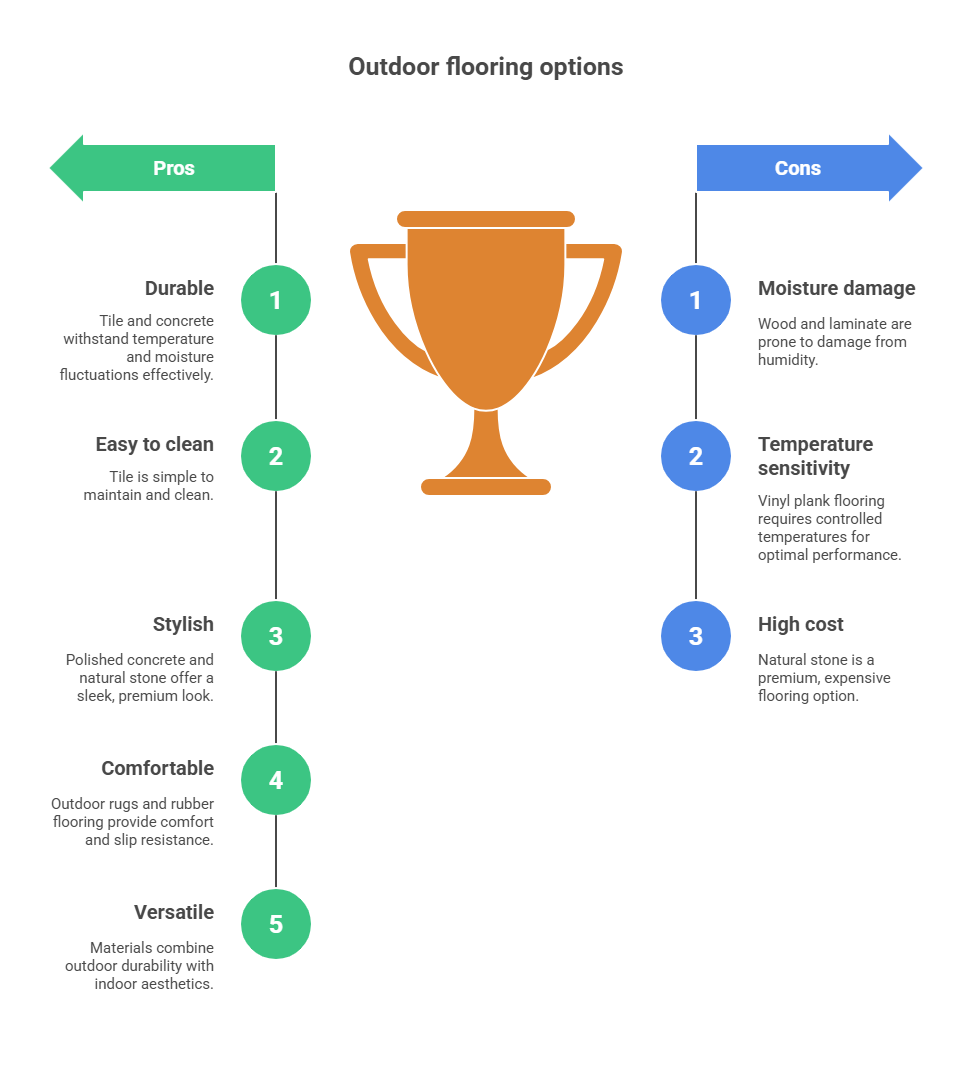
Concrete is a material that can be polished or stained to give it a sleek appearance and can withstand the conditions of the outdoors. The installation of vinyl plank flooring is most effective in enclosed spaces where the temperature can be more precisely controlled.
Even though it might need to be sealed, natural stone is a premium option. Avoid using wood and standard laminate, both of which are susceptible to damage when exposed to high levels of humidity.
Rugs designed specifically for use outside can be both comfortable and stylish. Rubber flooring is a choice that is both comfortable and resistant to slipping. Select a material that combines the durability of the outdoors with the allure of the indoors.
Pet-Friendly Flooring: Scratch-Resistant and Easy to Clean
Homes with pets need flooring that stands up to claws, fur, and accidents. Vinyl flooring is an excellent choice-it's scratch-resistant, waterproof, and comfortable.
Tile is also great for cleaning up messes and won't absorb odors. Laminate resists scratches but can be slippery for pets. Carpet can work in low-traffic pet areas, especially if it's stain-resistant and easy to vacuum.
Cork is soft, quiet, and resistant to mold. Engineered wood offers more durability than solid hardwood but still requires care. Foam rugs or mats can help in pet feeding zones. For reliable performance, consider to buy Republic Floor products online; they offer a variety of pet-friendly flooring options to suit any home.
Finding the Right Flooring for Every Room
Choosing the best flooring for each room in your home doesn't have to be stressful. Whether it's cozy carpet for bedrooms or durable tile for bathrooms, every material has unique strengths.
A well-planned flooring strategy adds value, comfort, and style. With so many affordable and attractive choices, matching each room's needs has never been easier.
Think about moisture levels, foot traffic, and personal taste to guide your decisions. With the right flooring, your home will look better and function more smoothly. Use this guide to find floors that suit your life perfectly.
For more helpful tips, browse our blog regularly!



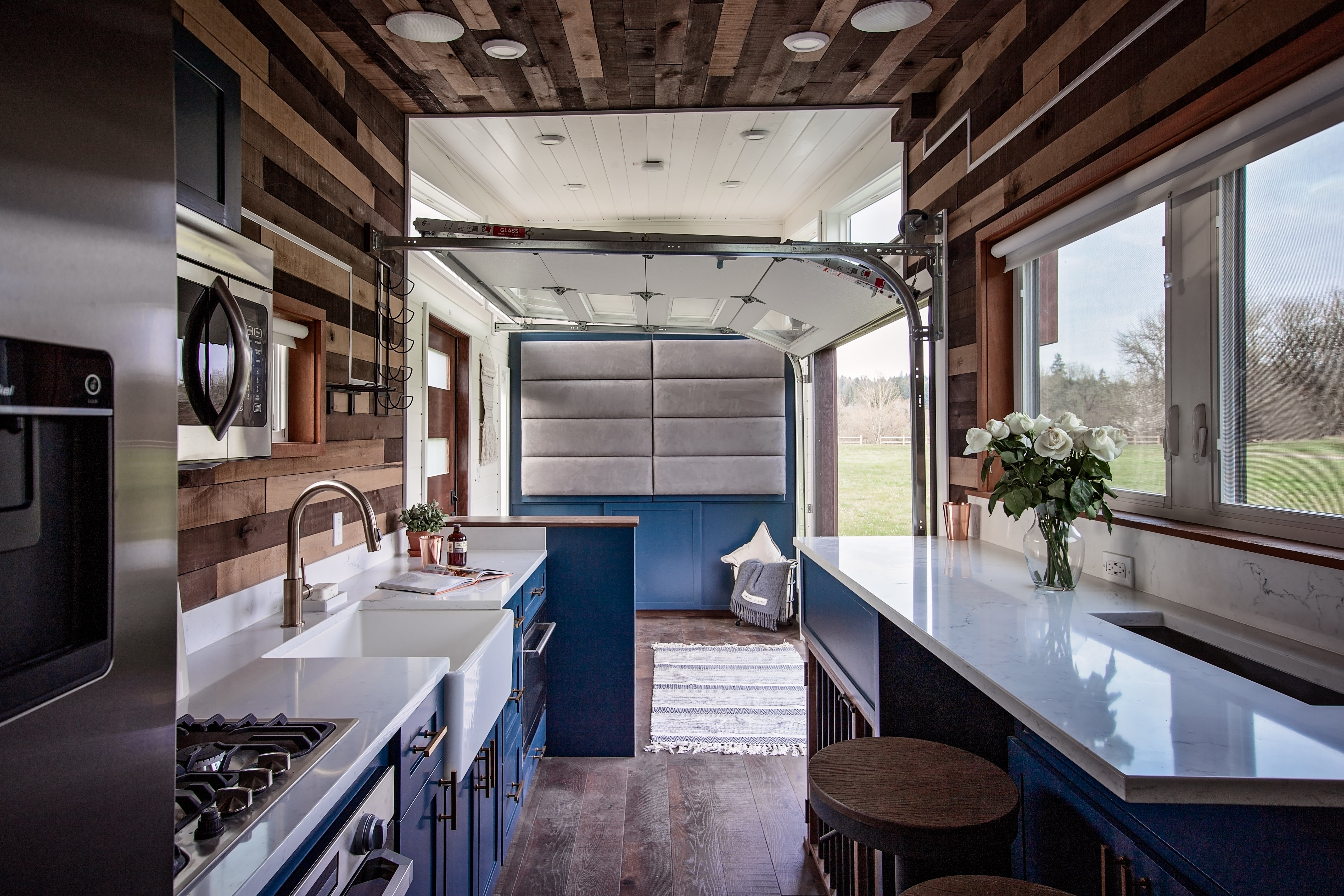
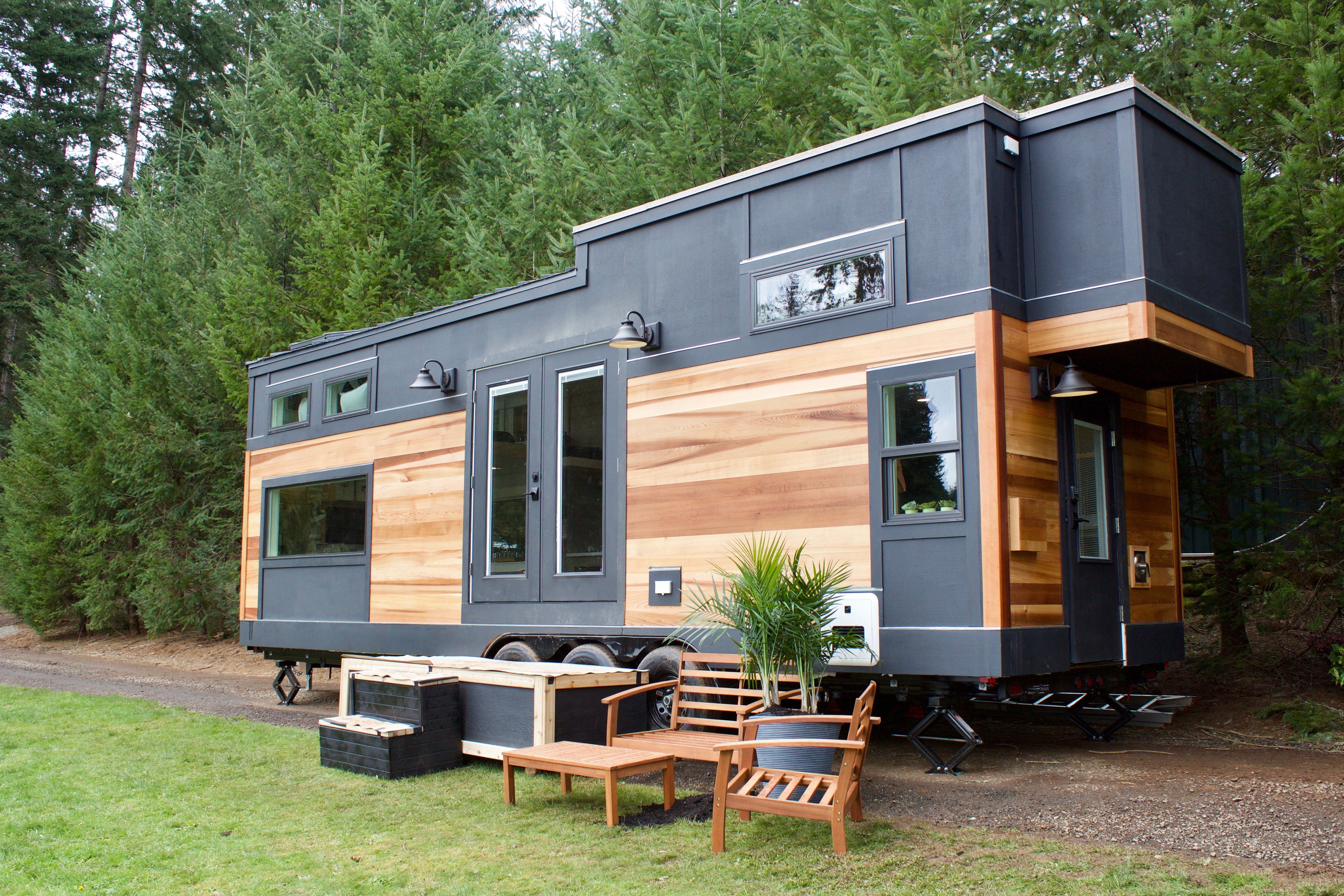
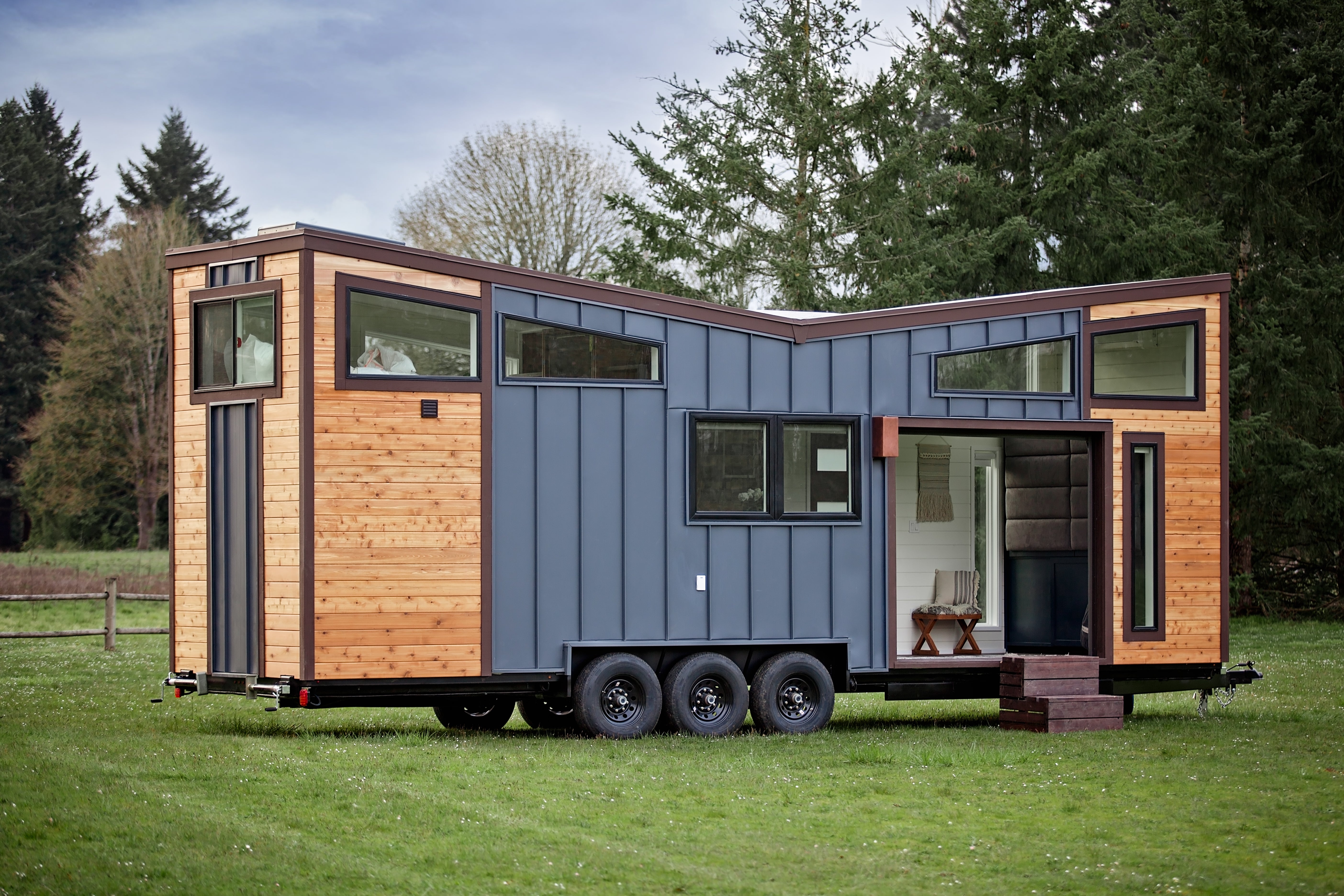
Share: